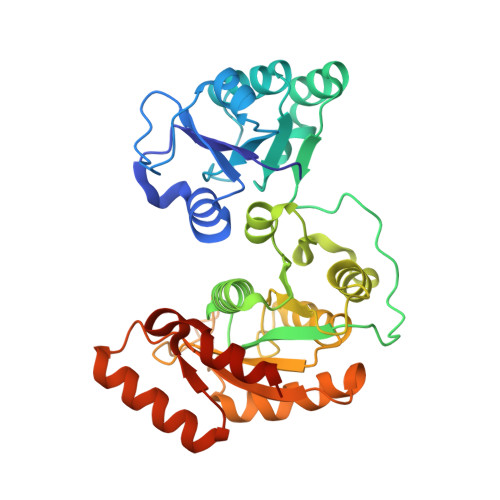Novel D-glutamate catabolic pathway in marine Proteobacteria and halophilic archaea.
Yu, Y., Wang, P., Cao, H.Y., Teng, Z.J., Zhu, Y., Wang, M., McMinn, A., Chen, Y., Xiang, H., Zhang, Y.Z., Chen, X.L., Zhang, Y.Q.(2023) ISME J 17: 537-548
- PubMed: 36690779
- DOI: https://doi.org/10.1038/s41396-023-01364-6
- Primary Citation of Related Structures:
7XRJ - PubMed Abstract:
D-glutamate (D-Glu) is an essential component of bacterial peptidoglycans, representing an important, yet overlooked, pool of organic matter in global oceans. However, little is known on D-Glu catabolism by marine microorganisms. Here, a novel catabolic pathway for D-Glu was identified using the marine bacterium Pseudoalteromonas sp. CF6-2 as the model. Two novel enzymes (DgcN, DgcA), together with a transcriptional regulator DgcR, are crucial for D-Glu catabolism in strain CF6-2. Genetic and biochemical data confirm that DgcN is a N-acetyltransferase which catalyzes the formation of N-acetyl-D-Glu from D-Glu. DgcA is a racemase that converts N-acetyl-D-Glu to N-acetyl-L-Glu, which is further hydrolyzed to L-Glu. DgcR positively regulates the transcription of dgcN and dgcA. Structural and biochemical analyses suggested that DgcN and its homologs, which use D-Glu as the acyl receptor, represent a new group of the general control non-repressible 5 (GCN5)-related N-acetyltransferases (GNAT) superfamily. DgcA and DgcN occur widely in marine bacteria (particularly Rhodobacterales) and halophilic archaea (Halobacteria) and are abundant in marine and hypersaline metagenome datasets. Thus, this study reveals a novel D-Glu catabolic pathway in ecologically important marine bacteria and halophilic archaea and helps better understand the catabolism and recycling of D-Glu in these ecosystems.
- State Key Laboratory of Microbial Technology, Shandong University, Qingdao, China.
Organizational Affiliation:

















